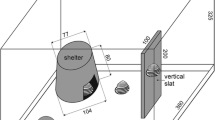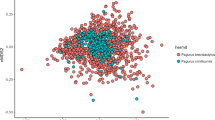Summary
Microspatial variation of banded and unbanded shell morphs frequencies as well as number of individuals per m2, mortality, migration and burrowing into the ground were examined in a population of snail Brephulopsis bidens found in South Crimea mountains (USSR). Differential values of relative survival of morphs were determined by their thermotolerance. The relative survival of the banded morph was lower at the west sites of population area (W=0.273), and increased gradually up to 1 at the east sites. Survival of the banded morph was dependent on its burrowing activity. Differences in relative survival of morphs decreased parallel with increasing general mortality of snails.
Burrowing activity and intensity of migration of the banded morph were significantly higher than that in unbanded. In experiments with artificial shaded sections, the banded morph preferred shaded sections, whereas unbanded chose illuminated sites. All these differences in behaviour probably form the main factors for microspatial variation of morph frequencies.
Similar content being viewed by others
References
Altukhov YP, Livshits GM (1978) Factors differentiating and integrating the gene pool of an isolated population of the mollusc Chondrus bidens (Kryn.). Doklady Adademii Nauk SSSR, 4:955–958 (Translated in English 1979)
Bantock CR, Batsey M (1980) Natural selection in experimental populations of the land snail Cepaea nemoralis. Heredity 44:1, 37–54
Cain AJ (1977) The efficacy of natural selection in wold populations. The changing scenes, 1776-1976, Acad Nat Sci Special Publication, 12:111–113
Cain AJ, Curry JD (1963) Area effects of Cepaea. Phil Trans Roy Soc London B 246:1–81
Cain AJ, Curry JD (1968) Studies of Cepaea. III. Ecogenetics of population of Cepaea nemoralis (L) subject of strong area effects. Phil Trans Roy Soc London B 253:447–482
Clarke B (1966) The evolution of morph ratio clines. Amer Natur 100:389–402
Clarke B (1979) Some contributions of snails to the development of ecological genetics. In: P Brussard (ed), Ecological genetics: the interface. Springer, Berlin Heidelberg New York, p 159–170
Clarke B, Artur W, Horsley DT, Parkin DT (1978) Genetic variation and natural selection in pulmonate molluscs. In: J Peake (ed), Pulmonates, Vol 2:219–270. NY Acad Press
Dzhamusova TA (1965) Heat contracture and irreversible loss of muscle excitability in connection with thermostability of muscle tissue. In Heat resistance of cells of animals. 8:61–69 Acad Sci USSR
Ford EB (1975) Ecological genetics. Chapman and Hall Ltd. London
Goodhart CB (1963) Area effects and non-adaptive variation between population of Cepaea (Mollusca). Heredity 23:18, 459–465
Greenwood JSD (1974) Effective population numbers in the snail Cepaea nemoralis. Evolution 28:4, 513–526
Hickson TGL (1972) A possible case of genetic drift in colonies of the land snail Theba pisana. Heredity 29:2, 177–190
Jones JS, Leith BH, Rawlings P (1977) Polymorphism in Cepaea: A problem with too many solutions? Anuu Ecol Syst 8:109–143
Johnson MS (1976) Allozymes and area effects in C. nemoralis on the Western Berkshire Downs. Heredity 36:1, 105–121
Lamotte M (1951) Recherchess sur la structure genetique des populations naturelles de Cepaea nemoralis (L). Bull Biol Fr Beg 35:1–239
Lamotte M (1959) Polymorphism of natural populations of Cepaea nemoralis. Cold Spring Harbor Symp Quant Biol 34:65–86
Lamotte M (1966) Les facteurs de la diversite du polymorphisme dans les populations naturelles de Cepaea nemoralis (L). Lav Soc malac Ital 3:33–73
Livshits GM (1978) Adaptive behaviour as a factor in the maintainance of the genetic stability of an isolated population of the land mollusc Chondrus bidens (Kryn.). Genetika (USSR) 14:3, 449–455 (Translated in English 1979)
Livshits GM, Shileyko AA (1978) Life cycle of mollusc Brephylopsis bidens. Ecologia (USSR) 5:77–83
Moran PA (1962) The statistical processes of evolutionary theory. The Clarendon Press, Oxford
Richardson AMM (1974) Differential climatic selection in natural population of land snail Cepaea nemoralis. Nature 237:572–573
Sedlmair J (1956) Verhaltens-, Resistenz- und Gehäuse- Unterschiede bei den polymorphen Banderschnecken Cepaea hortensis (Mull.) und C. nemoralis (L). Biol Zbl 75:281–313
Selander RK, Kaufman DW (1975) Genetic structure of the populations of brown snail (Helix aspersa). Evolution 29:3, 385–401
Sokal RR, Rohlf FJ (1969) Biometry. Freeman, San Francisco
Wolda H (1965) Some preliminary observations on the distribution of the various morphs within natural populations of the polymorphic landsnail Cepaea nemoralis (L). Archives neerlandaises de zoologie 15:1, 280–292
Author information
Authors and Affiliations
Rights and permissions
About this article
Cite this article
Livshits, G.M. Survival, behaviour and spatial distribution of shell morphs in a population of the snail Brephulopsis bidens (Pulmonata) . Oecologia 51, 220–226 (1981). https://doi.org/10.1007/BF00540605
Received:
Issue Date:
DOI: https://doi.org/10.1007/BF00540605




